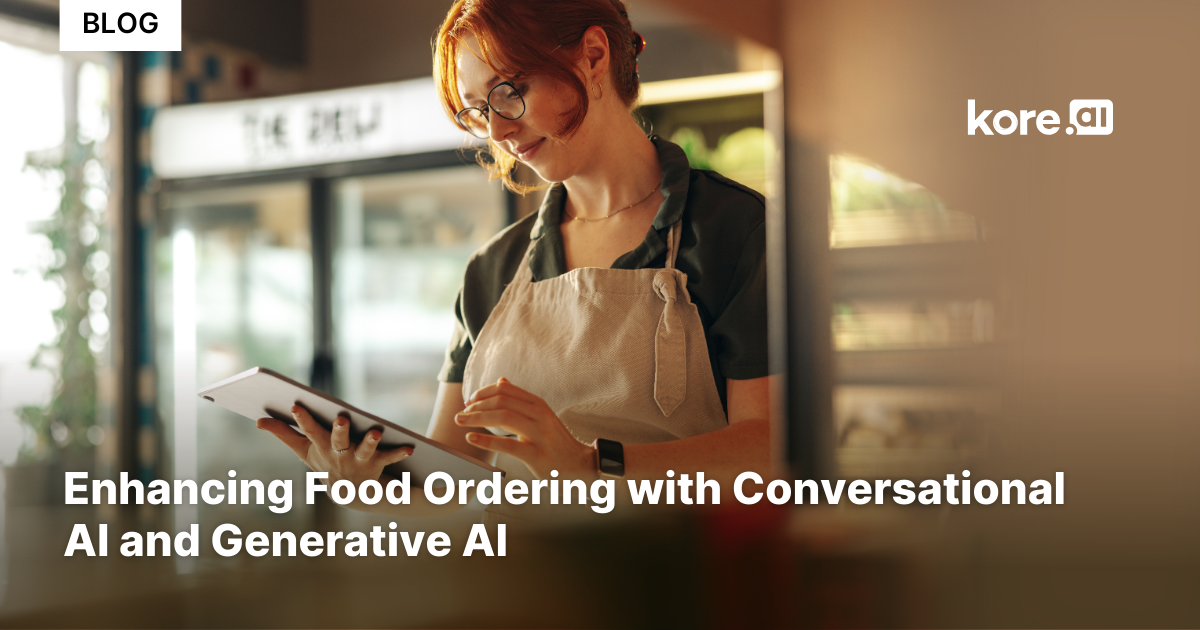In today’s fast-paced world, technology has revolutionized the way we order food. Kore.ai, a leading provider of AI solutions, is at the forefront of transforming the food industry through the integration of Conversational AI and Generative AI into various aspects of food ordering.
I see there are five distinct solutions that could be built using coversational AI and generative AI tailored to the food industry, each addressing specific needs and enhancing the overall customer experience. Companies like DoorDash, Uber Foods, Zomato have launched various automated food ordering solutions.
1. Digital Virtual Agents for Self-Service Kiosks
These kiosks with Digital virtual agents can offer customers a seamless and interactive way to place their food orders. Here’s how they work:
- Conversational Abilities: These virtual agents are designed to engage in natural language conversations with customers. Customers can ask questions about dietary restrictions, allergens, food preparation methods, and more. The virtual agent responds with accurate information, helping customers make informed choices.
- Customization: Customers can customize their orders to their preferences. Whether it’s adjusting toppings, choosing a specific cooking method, or modifying portion sizes, the virtual agent accommodates these requests, ensuring a personalized dining experience.
- Assistance: If customers encounter any issues or have complex requests, the virtual agent can seamlessly transition the conversation to a human representative, providing real-time assistance. This blend of AI and human support enhances customer satisfaction.
2. Automated Telephone Food Ordering
Streamlining food orders through automated telephone systems. This solution is equipped with adaptive order-taking capabilities powered by AI. Here’s how it simplifies the ordering process:
- Adaptive AI: The AI-driven system can handle phone orders efficiently by adapting to customer needs. For instance, when ordering pizza, it can ask questions like pizza type, base, toppings, specials, drinks, and desserts, ensuring all order details are captured accurately.
- Visual IVR: To further enhance the experience, Visual Interactive Voice Response (IVR) system could enhance the overall user experience and order accuracy. This allows customers to interact with both digital and voice bots simultaneously. Visual IVR displays options on a screen, making it easier for customers to navigate and place orders.
- Efficiency: By automating the ordering process, restaurants can significantly reduce errors and increase order accuracy. This leads to faster service and improved customer satisfaction.
3. Drive-Through Automation
All most every QSR is exploring various drive through solutions and there are many challanges with these solutions. The ideal solution should leverage local fine-tuned Language Models (LLMs) to streamline drive-through operations:
- Local LLMs: These Language Models are trained specifically for the restaurant’s menu and operations. They understand local accents and nuances, ensuring accurate order taking.
- Integration with POS: The LLMs are seamlessly integrated with the Point of Sale (POS) systems within the restaurant. This integration minimizes delays and latencies, ensuring that orders are processed swiftly and efficiently.
- Order Accuracy: By using LLMs, restaurants can ensure that customer orders are taken correctly, reducing instances of incorrect orders and customer dissatisfaction.
4. Customer Service Bot
QSR and Resturants have digitally accelarated during the covid times but most of the Food chains donot even have customer support bot to hear from customers. so, it is critical to improve customer service within the food industry. Some of the key use cases for the customer service bots are:
- Misplaced Deliveries: In cases where a customer’s order goes missing or is delivered to the wrong address, the customer service bot can assist in tracking the order and arranging a re-delivery if necessary.
- Missing Orders: If a customer’s order is missing items or there are discrepancies, the bot can quickly address the issue, arrange refunds or replacements, and ensure customer satisfaction.
- Quality of Food: Customers can provide feedback on the quality of their food. The bot can process this feedback, enabling restaurants to maintain high food quality standards.
- Delivery Service: For questions or concerns about delivery times, the delivery process, or driver behavior, the customer service bot can provide real-time assistance and updates.
5. Employee Assistant BOT:
Restaurants are dealing with lot of attrition and unable to run the stores due to lack of skilled labor and it is extremely important to make the onboarding, training and upskilling people every important.
- Knowledge gaps: Today most of the people may not know how to cook a veggie delight pizza and what are the topping on it. Generative AI could help employee ask these questions using their Google Home/Alexa and get the relevant answers based on the QSR menu and processes to make food
- Employee onboarding and training : Employees could manage thiers request time off, leaves, and approvals conveniently. Chatbots could enable HR teams to engage in intuitive conversations and provides quick access to information regarding benefits and workforce attendance in real-time.
- IT support and tech assistance: A chatbot could be performing IT service management by allowing employees to search for and request passcode resets and get self help on numerous use cases like POS issues, WiFi issues, freezer broken, soda machine not workings without complex forms or catalogs.
In conclusion, Conversational AI and Generative AI could be leveraged in enhancing overall customer and employee experience. From self-service kiosks to drive-through automation and customer service support, these solutions not only streamline operations but also improve customer satisfaction and loyalty.







